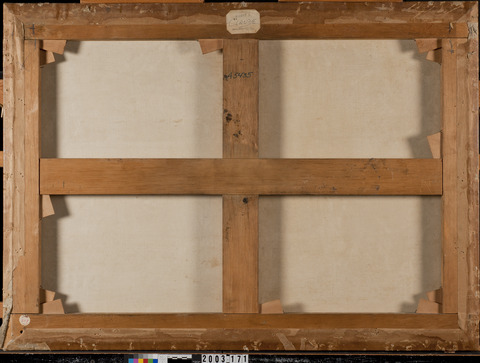Overview
Accession number: 2003.171
Artist: Claude Lorrain
Title: The Flight into Egypt
Materials: Oil (untested) on canvas
Date of creation: About 1635
Previous number/accession number: C10052
Dimensions: 72.5 × 99 cm
Conservator/examiner: Fiona Beckett
Examination completed: 2016
Distinguishing Marks
Front:
Item 1. Signature executed in black paint located on a rock in the foreground, bottom center. The signature was compared to E. Bénézit’s Dictionnaire critique et documentaire des peintres, sculpteurs, dessinateurs et graveurs.1 Although the signature is slightly abraded in the painting, it corresponds with Claude Lorrain’s signature as documented in the publication (tech. fig. 1).
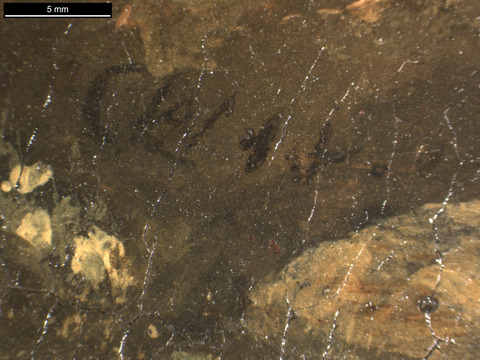
Back:
Item 2. Inscription in black marker “A5435,” top of the vertical stretcher bar (tech. fig. 2).
Item 3. Paper label with “Claude” handwritten in pen and “X Agnew” handwritten upside-down in pen (tech fig. 2).
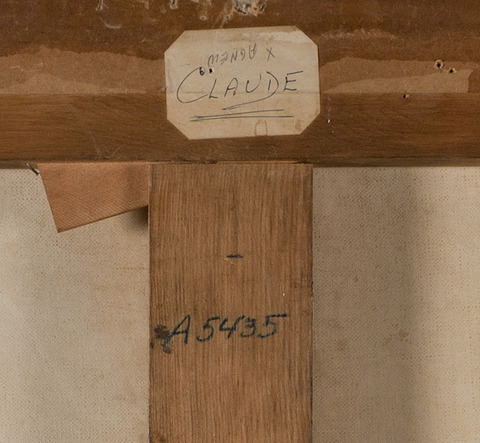
Item 4. Circular sticker in the bottom-left corner of the stretcher, partially legible: at top " _las_c" followed by “359” handwritten in red pencil and “varnish” at the bottom (tech. fig. 3).
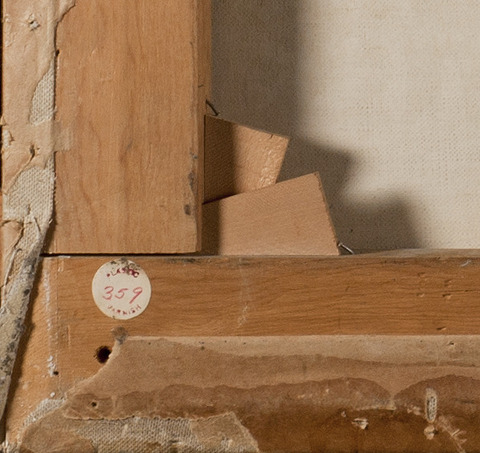
Summary of Treatment History
Documentary and physical evidence suggest the painting has a long history of treatment before coming into Dr. Clowes’s collection. Interventions include lining and several restoration campaigns of varnish and retouching removal. A cost estimate and treatment recommendation were sent to Allen Clowes from Daniel Goldreyer LTD in 1961. This document recommended this painting be faced, the old lining removed, and a new glue lining on pure Irish linen applied. This report also recommended the removal of overpaint, filling-sealing, and inpainting losses, as well as the application of a semimatte varnish, binding the edges with fiber paper, and wiring in the stretcher keys.2 No treatment report for this intervention has been retained, but the physical evidence on the painting suggests it almost certainly occurred.
Documentation notes a series of condition assessments and treatments that were carried out on the collection about the time the works were moved from the Clowes residence to the IMA in 1971. A condition report by Paul Spheeris in October of that year, likely carried out before the paintings were relocated, described the painting as having a small damage to the frame. No treatment to the painting was recommended.3 A second condition assessment was carried out upon arrival of the paintings at the IMA. This assessment described the work as in good condition, and no work was deemed necessary.4
The most recent round of treatments occurred between 1978 and 1983. In 1978, the painting was consolidated with gelatin 1-10 in water with a heated spatula, as well as cleaned with deionized water. In 1981, conservation work was completed by Martin Radecki. At this time, the varnish and retouching were removed, a brush coat of Paraloid B-67 was applied, inpainting with AYAB and dry pigments was carried out, and three layers of spray varnish of Paraloid B-67 were applied. Additionally, Paraloid B-67 was applied locally with a brush, and a spray varnish of Paraloid B-72 was applied to the painting in 1983. The reports on file at the IMA suggest that possible additional minor treatments also occurred.5
The painting was inspected in the Clowes Collection annual survey from 2011 to 2020.
Current Condition Summary
Structurally, the painting is in good condition. It has remained in a stable environment with very little shift in temperature and relative humidity and does not show signs of distress. There is some abrasion in the paint layers from much older restoration campaigns and possibly blanching (not uncommon in paintings by Claude Lorrain). Despite this, the painting is in good condition with the varnish adequately saturating the paint layers. Minor retouching and varnish application could improve the painting’s appearance.
Methods of Examination, Imaging, and Analysis
| Examination/Imaging | Analysis (no sample required) | Analysis (sample required) |
|---|---|---|
| Unaided eye | Dendrochronology | Microchemical analysis |
| Optical microscopy | Wood identification | Fiber ID |
| Incident light | Microchemical analysis | Cross-section sampling |
| Raking light | Thread count analysis | Dispersed pigment sample |
| Reflected/specular light | X-ray fluorescence spectroscopy (XRF) | Fourier-transform infrared spectroscopy (FTIR) |
| Transmitted light | Macro X-ray fluorescence scanning (MA-XRF) | Raman microspectroscopy |
| Ultraviolet-induced visible fluorescence (UV) | ||
| Infrared reflectography (IRR) | Gas chromatography–mass spectrometry (GC-MS) | |
| Infrared transmittography (IRT) | Scanning electron microscope-energy dispersive X-ray spectroscopy (SEM-EDS) | |
| Infrared luminescence | Other: False-color infrared (FCIR) | |
| X-radiography |
Technical Examination
Description of Support
Analyzed Observed

Material (fabric, wood, metal, dendrochronology results, fiber ID information, etc.):
The painting is executed on a thickly woven plain weave canvas (11 × 12 threads/cm) (tech. fig. 5).
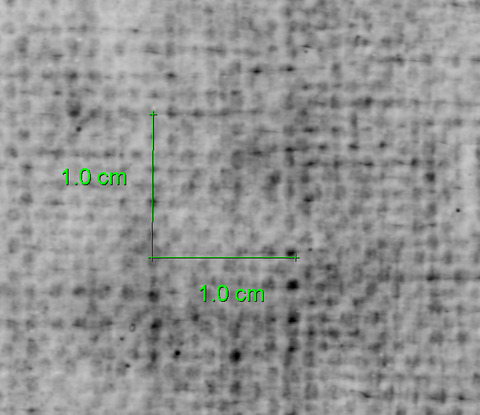
Characteristics of Construction / Fabrication (cusping, beveled edges of panels, seams, joins, battens):
Cusping is visible along all edges, suggesting the painting is close to its original size.
Thickness (for panels or boards):
N/A
Production/Dealer’s Marks:
None
Auxiliary Support:
Original Not original Not able to discern None
The painting is stretched on a six-member wooden stretcher with two crossbars that does not appear to be original to the painting. The painting has a twentieth-century glue lining with brown paper tape along all four tacking margins overlapping the front of the painting by 5 mm, likely applied during the 1961 treatment (see Summary of Treatment History). The tape obscures the tacks, which are visible in the X-radiograph (tech. fig. 4). The brown paper tape is partially removed in the upper-right and lower-right corners. The back of the lining canvas is painted off-white.
Condition of Support
The auxiliary support is in stable condition and does not show any sign of delamination. All 12 stretcher keys are present. The original canvas, where visible, is in good condition. No large areas of loss to the support are visible in the X-radiograph. The edges of the canvas are somewhat raggedly cut, likely at the time when the painting was lined and the original tacking margins were removed. A crease and minor losses are visible along some of the edges, suggesting that the painting was once folded at these points. The damage, however, is minimal with no evidence of tack holes, so it is unlikely that these creases were previous tacking margins.
Description of Ground
Analyzed Observed
A single medium-thickness layer of white ground appears present over the entire surface of the painting. This is visible along the bottom edge.
Materials/Binding Medium:
There appears to be a calcium-containing ground layer, as analysis by XRF indicates a presence of calcium throughout the painting. Likely, the canvas was sized and then primed with an oil-based chalk mixture.
Color:
Off-white
Application:
Likely brush applied or scraped on with a hard-edged tool, such as palette knife
Thickness:
Medium
Sizing:
While difficult to determine without further analysis, the canvas was likely sized prior to the addition of the ground layer.
Character and Appearance (Does texture of support remain detectable / prominent?):
The texture of the canvas as well as weave interference from the glue lining are visible through the ground and paint layers.
Condition of Ground
The ground layer is in good condition and remains intact. It exhibits craquelure consistent with that of natural aging of canvas paintings. The craquelure is not very distracting from the overall composition. No major losses are present; however, some small fills are present along the edges.
Description of Composition Planning
Methods of Analysis:
Surface observation (unaided or with magnification)
Infrared reflectography (IRR)
X-radiography
Analysis Parameters:
| X-radiography equipment | GE Inspection Technologies Type: ERESCO 200MFR 3.1, Tube S/N: MIR 201E 58-2812, EN 12543: 1.0mm, Filter: 0.8mm Be + 2mm Al |
|---|---|
| KV: | 21 |
| mA: | 3 |
| Exposure time (s) | 90 |
| Distance from X-ray tube: | 36″ |
| IRR equipment and wavelength | Opus Instruments Osiris A1 infrared camera with InGaAs array detector operating at a wavelength of 0.9–1.7µm. |
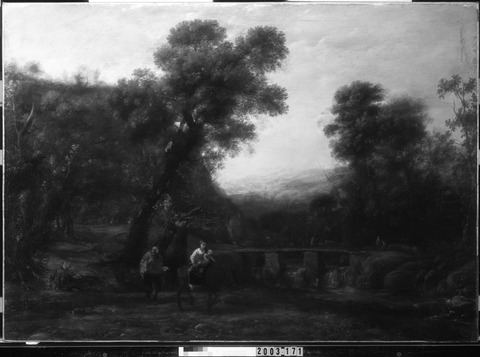
Medium/Technique:
Underpainting can be seen when the painting is imaged using infrared reflectography (tech. fig. 6). Black outlines and slight refinements are visible and were done using a fluid carbon-containing medium (most likely an ink or carbon black paint). These are primarily present in the foreground, where the figures and the bridge are located, although they cannot be clearly discerned in all the figures. It is likely that additional underpainting exists but is disguised by the use of lead white paint in subsequent layers of the composition.
Pentimenti:
No pentimenti are visible, although slight adjustments during the underpainting phase are visible. The most obvious of these is the figure of the seated man on the left side of the painting, where the black lines were reinforced and adjusted (see tech. fig. 7).
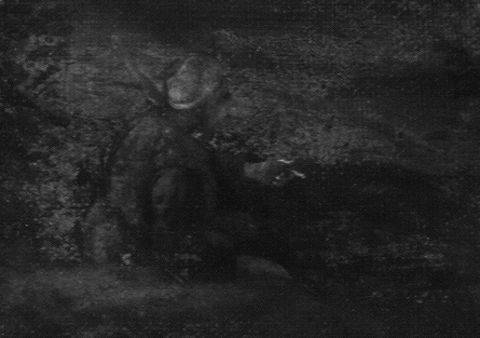
Description of Paint
Analyzed Observed
Application and Technique:
The paint was applied in both wet-in-wet and wet-over-dry techniques, which allow for the smooth blending of paint, as seen in the mossy areas and the rocks, as well as the crisper edges of the leaves.
Painting Tools:
Larger brushes were used for the background and initial layers, while smaller brushes were used for fine details in the figures (tech. fig. 8) and leaves of the trees.
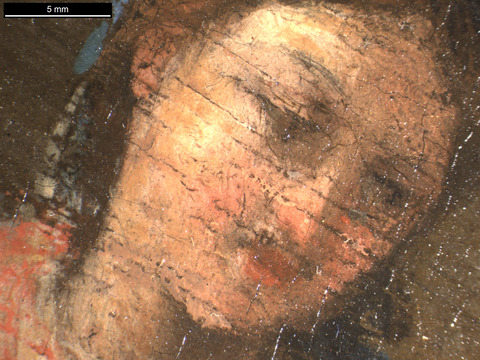
Binding Media:
Likely linseed oil
Color Palette:
The color palette is composed of whites and blues for the sky and Mary’s robe (tech. fig. 9), greens and earth tones for most of the painting, with a few additional reds and yellow for the figures. Previous studies of Claude’s work have found that he often used layering systems with varnish interlayers and “…used his pigments very finely ground, mixing green earth, ultramarine, smalt, ochres, blacks and whites into what could almost be called the typical Claude mixture."6 Perhaps unsurprisingly, XRF analysis suggested the presence of numerous pigments in nearly all locations. The presence of lead throughout the painting indicates that lead is likely present in the priming or a background layer that has been applied over most of the surface (this is also apparent in the X-radiograph). Other major elements include iron, calcium, copper, and mercury. The possible pigments related to these elements include vermilion; iron oxide (earth pigments); calcium, likely as part of the ground layer; and copper-containing blue and/or green such as malachite, copper resinate, (or oleate) and/or azurite. In the yellow area of Joseph’s top, the element antimony was found, suggesting that Naples yellow could have been used in a restoration campaign.
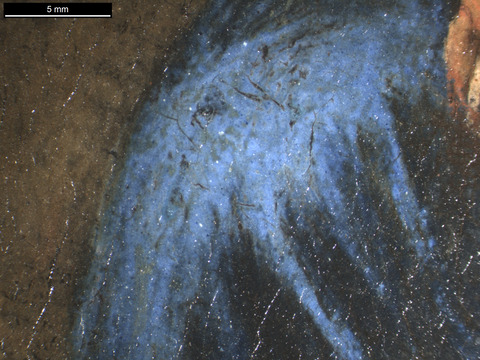
Some of the black leaves were executed in a much crisper manner and with thicker paint than is usual in Claude’s portrayal of foliage, suggesting perhaps they were not by the artist’s hand. However, the black paint appears to have a naturally formed cracking network, which points to it being an old paint film (tech. fig. 10). XRF analysis in these areas indicated the presence of cobalt, copper, nickel, and iron. This could suggest the presence of spinel black. Spinel black was synthetically produced in the eighteenth century and would therefore likely be retouching. However, it can also sometimes occur naturally. It is also possible that some areas include smalt blue (which also contains cobalt). Black, crisp foliage is also present in some of Claude’s other paintings, so it is difficult to tell how much of it is retouching and what is original. More analysis, including sampling, would have to be done to determine if a layer structure is present and precisely what pigments were used.

In addition to XRF, a false-color infrared image (FCIR) (tech. fig. 11) was generated to further define differences in pigments used in the sky. Using the different reflectance values of pigments in the infrared region of the spectrum, and combining information gathered from the FCIR with the results of XRF, it is possible to narrow down and differentiate between pigments that originally appear to be the same. While the color and appearance of the sky in the painting suggest a single color, ultramarine, was used for the entire sky, the FCIR image clearly shows red areas and blue areas, indicating that the use of two blue pigments is more likely. Both smalt blue and ultramarine appear red in FCIR (both pigments that Claude would have used); however, the lack of cobalt in the XRF readings in this area make smalt unlikely and ultramarine very likely. The bright aqua in the FCIR image could possibly be blue bice (a copper-carbonate pigment) that appears blue in FCIR, though additional analysis would be required. Additionally, the red present in Mary’s robe appears yellow in the FCIR image and, coupled with the XRF information indicating the presence of mercury, correlates to the use of vermilion in this area.
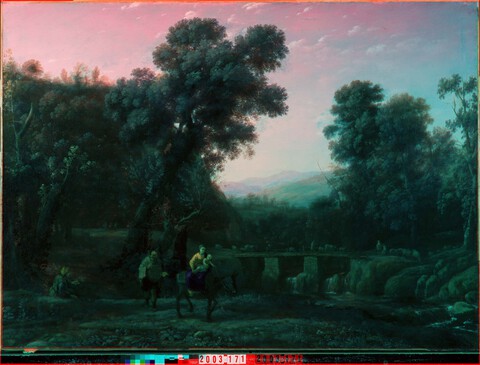

XRF Analysis:
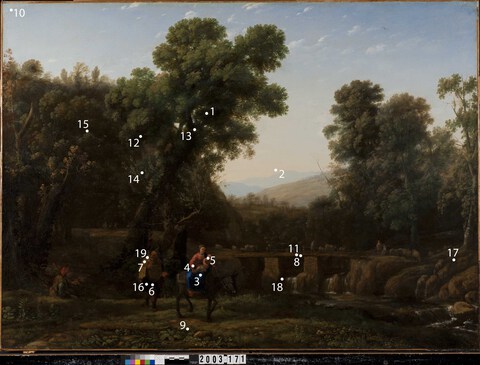
| Sample | Location | Elements | Possible Pigments |
|---|---|---|---|
| 1 | Dark green in trees | Major: Pb, Fe, Cu Minor: K, Ca Trace: Ti, Mn | Lead white, iron oxide (earth pigments including green earth), copper-containing green pigment or azurite, calcium (likely from ground layer), trace of titanium (likely impurity from earth pigments), trace of manganese from umber pigment (or iron oxide impurity). |
| 2 | Light blue in sky | Major: Pb Minor: Fe Trace: Ca, Ti, Mn | Lead white, iron oxide (earth pigments), trace of calcium (likely from ground), trace of titanium (likely impurity from earth pigments), trace of manganese from umber pigment (or iron oxide impurity). |
| 3 | Blue robe of Mary | Major: Pb Minor: Fe, Cu, Ca, K Trace: Mn | Lead white, iron oxide (earth pigments including green earth), azurite, calcium (likely from ground), trace of titanium (likely impurity from earth pigments), trace of manganese from umber pigment (or iron oxide impurity). |
| 4 | Red robe of Mary | Major: Hg, Pb Minor: Fe Trace: Ca, Cu, Mn | Vermilion, lead white, iron oxide (earth pigments including green earth), traces of calcium (likely from ground), traces of copper-containing green pigment or azurite, trace of manganese from umber pigment (or iron oxide impurity). |
| 5 | Skin tone of baby Jesus | Major: Pb, Hg, Fe Minor: Cu, Ca, K Trace: Ti, Mn | Lead white, vermilion, iron oxide (earth pigments including green earth), copper-containing green pigment or azurite, calcium (likely from ground), trace of titanium (likely impurity from earth pigments), trace of manganese from umber pigment (or iron oxide impurity). |
| 6 | Black pants of Joseph | Major: Cu, Pb, Fe Minor: Co, Ca, Ni, K Trace: Hg, Mn, Ti | Possibly spinel black (alternatively carbon black with smalt), lead white, iron oxide (earth pigments including green earth), calcium (likely from ground), trace of titanium (likely impurity from earth pigments), trace of manganese from umber pigment (or iron oxide impurity). |
| 7 | Yellow jacket of Joseph | Major: Fe, Pb Minor: Ca, Cu, Trace: Mn, Hg, Ti, Sb | Lead white, iron oxide (earth pigment likely including yellow ochre and green earth), calcium (likely from ground), copper-containing green pigment or azurite, trace of titanium (likely impurity from earth pigments), trace of manganese from umber pigment (or iron oxide impurity), traces of vermilion, trace of Naples yellow. |
| 8 | Brown in bridge | Major: Pb, Fe Minor: Cu, Ca, K Trace: Mn, Ti | Lead white, iron oxide, azurite or malachite, calcium (possibly from ground), potassium (possibly from mordant for dye-based pigment), trace of titanium (likely impurity from earth pigments), trace of manganese from umber pigment (or iron oxide impurity). |
| 9 | Light green in foliage | Major: Pb, Fe Minor: Sb, K Trace: Hg, Cu, Mn | Lead white, iron oxide (earth pigments including green earth), Naples yellow, trace of vermilion, trace of copper-containing green pigment or azurite, trace of manganese from umber pigment (or iron oxide impurity). |
| 10 | Blue in sky top left | Major: Pb Minor: Trace: Fe, K, Ti | Lead white, traces of iron oxide (earth pigments including green earth), trace of titanium (likely impurity from earth pigments). |
| 11 | Black in bridge | Major: Pb, Cu, Fe Minor: Ca, K Trace: Mn, Ti | Lead white, copper-containing green pigment or azurite, iron oxide (earth pigments including green earth), calcium (likely from ground layer), trace of titanium (likely impurity from earth pigments), trace of manganese from umber pigment (or iron oxide impurity). |
| 12 | Darkest crisp foliage area | Major: Cu, Pb, Fe Minor: Ca, K Trace: Ti, Si | Copper-containing green pigment and/or azurite, lead white, iron oxide (earth pigments including green earth), calcium (likely from ground layer), trace of titanium (likely impurity from earth pigments). |
| 13 | Lighter dark-colored leaves | Major: Pb, Fe, Cu Minor: Ca, K Trace: Mn, Ti, Si | Lead white, iron oxide, copper-containing green pigment and/or azurite, calcium (likely from ground layer), trace of titanium (likely impurity from earth pigments), trace of manganese from umber pigment (or iron oxide impurity). |
| 14 | Darker green leaves in tree | Major: Pb, Fe, Cu Minor: Ca, K Trace: Ti, Si | Lead white, iron oxide (earth pigments including green earth), copper-containing green pigment or azurite, calcium (likely from ground layer), trace of manganese from umber pigment (or iron oxide impurity). |
| 15 | Leaves top left | Major: Cu, Pb, Fe Minor: Ca, K Trace: Ti, Mn, Si | Lead white, copper-containing green pigment or azurite, iron oxide (earth pigments including green earth), calcium (likely from ground layer), trace of titanium (likely impurity from earth pigments), trace of manganese from umber pigment (or iron oxide impurity). |
| 16 | Black pants of Joseph | Major: Cu, Pb, Fe, Co Minor: Ca, Ni, K Trace: Hg, Mn, Ti | Possibly carbon black with smalt, lead white, iron oxide (earth pigments including green earth), calcium (likely from ground), trace of vermilion, trace of titanium (likely impurity from earth pigments), trace of manganese from umber pigment (or iron oxide impurity). |
| 17 | Dark foliage near cows | Major: Fe, Pb, Cu Minor: K, Ca Trace: Mn, Ti, Si | Lead white, copper-containing green pigment or azurite, iron oxide (earth pigments including green earth), calcium (likely from ground layer), trace of titanium (likely impurity from earth pigments), trace of manganese from umber pigment (or iron oxide impurity). |
| 18 | Dark area under bridge | Major: Pb, Fe Minor: Co, Cu, Ca, K, Ni Trace: Si, Ti, Mn | Lead white, copper-containing green pigment or azurite, smalt, iron oxide (earth pigments including green earth), calcium (likely from ground layer), trace of titanium (likely impurity from earth pigments), trace of manganese from umber pigment (or iron oxide impurity). |
| 19 | Yellow in Joseph’s top | Major: Fe, Pb Minor: Sb, Cu, K Trace: Mn, Hg, Ti, Si | Lead white, iron oxide (earth pigment likely including yellow ochre and green earth), Naples yellow, copper-containing green pigment or azurite, trace of titanium (likely impurity from earth pigments), trace of manganese from umber pigment (or iron oxide impurity), traces of vermilion. |
Table 1: Results of X-ray fluorescence analysis conducted with a Bruker Artax microfocus XRF with rhodium tube, silicon-drift detector, and polycapillary focusing lens (~100μm spot).
*Major, minor, trace quantities are based on XRF signal strength not quantitative analysis
Surface Appearance:
The paint appears well mixed and finely ground (as was Claude’s habit). There are few areas of impasto, and the colors appear to be well preserved.
Condition of Paint
The paint is in good condition. Abrasion is visible in some areas, in particular the glazes and the leaves (tech. fig. 13), which have suffered due to overzealous cleaning initiatives. The buildings in the background are also barely visible. Small losses are present throughout the painting. Some areas of impasto were flattened during the lining process, and some weave interference is present in the paint layer. The paint layer also exhibits a craquelure pattern due to natural aging.
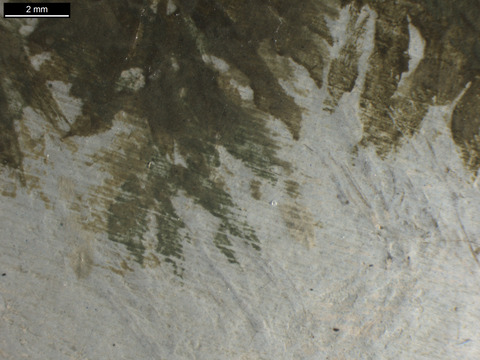
Description of Varnish/Surface Coating
Analyzed Observed Documented
| Type of Varnish | Application |
|---|---|
| Natural resin | Spray applied |
| Synthetic resin/other | Brush applied |
| Multiple Layers observed | Undetermined |
| No coating detected |
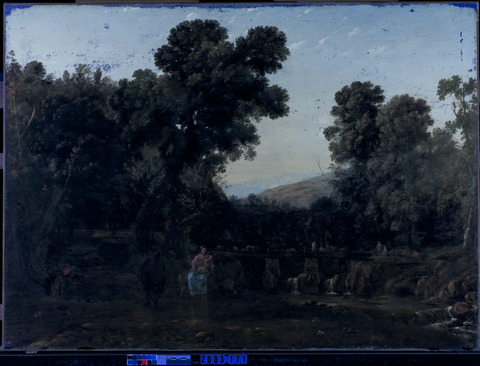
A late twentieth-century synthetic varnish is present over the entire surface of the painting in a semigloss sheen (Paraloid B-72 and Paraloid B-67 are included in the previous treatment record as having been applied in 1983 and 1981). Some natural resin residues are present from a previous varnish coating. These are predominantly present in the darker areas, such as the foliage and some of the foreground. It is possible that a previous cleaning campaign was done selectively. Additionally, some fluorescence characteristic of aged resin is present in the darker areas, indicating that possibly glazes are present in these areas (tech. fig. 14).
Condition of Varnish/Surface Coating
The varnish is in good condition. The varnish was evenly applied and adequately saturates the paint. There is minor scuffing present in the varnish. A light layer of surface dirt and dust is present, but this will likely be removed with regular dusting in the galleries. Retouching is present in several areas throughout the painting. Much of the retouching is delicately applied, such as in the sky and particularly in Mary’s face. Black retouching in the leaves appear to be the most obvious and are from an earlier restoration campaign, as it also exhibits cracking (though this does not appear to be the original craquelure).
Description of Frame
Original/first frame
Period frame
Authenticity cannot be determined at this time/ further art historical research necessary
Reproduction frame (fabricated in the style of)
Replica frame (copy of an existing period frame)
Modern frame
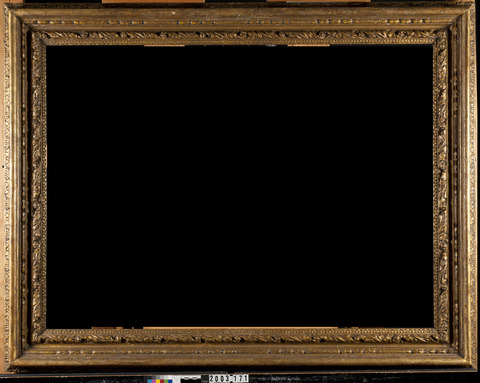
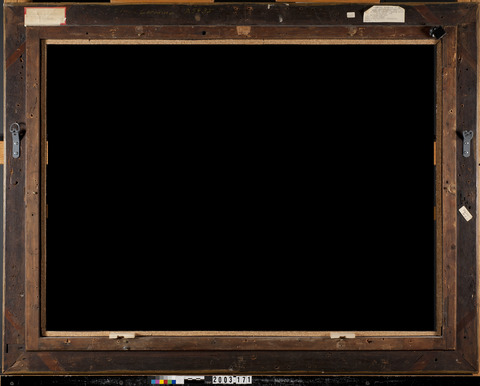
Frame Dimensions:
Outside dimensions: 18.5 × 19.8 × 3 cm
Distinguishing Marks:
None
Description of Molding/Profile:
The frame comprises four members with mitered corners (tech. fig 15).
Condition of Frame
The frame is structurally sound and in good condition. Previous infestation from woodworms left tunneling and flight holes, however no infestation is active (tech. fig 16).
Notes
-
E. Bénézit, Dictionnaire critique et documentaire des peintres, sculpteurs, dessinateurs et graveurs, 10 vols., reprint ed. (Paris: Librarie Gründ, 1966). ↩︎
-
Letter from Daniel Goldreyer to Allen Clowes, 22 Sept 1961, Conservation Department Files, Indianapolis Museum of Art at Newfields. ↩︎
-
Paul A.J. Spheeris, “Conservation Report on the Condition of the Clowes Collection,” 25 October 1971, Conservation Department Files, Indianapolis Museum of Art at Newfields. ↩︎
-
Martin Radecki, Clowes Collection condition assessment, undated (after October 1971), Conservation Department Files, Indianapolis Museum of Art at Newfields. ↩︎
-
Martin Radecki, Treatment report, C10052 (2003.171), 1983, Conservation Department Files, Indianapolis Museum of Art at Newfields. ↩︎
-
Karin Groen, “Scanning Electron-microscopy as an Aid in the Study of Blanching,” in The First Ten Years: The Examination and Conservation of Paintings, 1977 to 1987 (Cambridge: The Hamilton Kerr Institute of the Fitzwilliam Museum, 1988), 49. ↩︎
Additional Images

